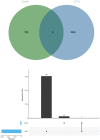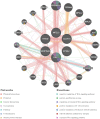Exploration of the common pathogenic link between COVID-19 and diabetic foot ulcers: An in silico approach
- PMID: 37936615
- PMCID: PMC10626003
- DOI: 10.1002/hsr2.1686
Exploration of the common pathogenic link between COVID-19 and diabetic foot ulcers: An in silico approach
Abstract
Background and aims: The Coronavirus Disease-19 (COVID-19) is posing an ongoing threat to human health. Patients of diabetic foot ulcer (DFU) are susceptible to COVID-19-induced adverse outcomes. Nevertheless, investigations into their mutual molecular mechanisms have been limited to date. In the present work, we tried to uncover the shared pathogenesis and regulatory gene targets of COVID-19 and DFU.
Methods: In this study, we chose GSE161281 as the COVID-19 data set, which contained severe acute respiratory syndrome coronavirus 2 infected human induced embryonic stem cell-derived peripheral neurons (n = 2) with uninfected controls (n = 2). The GSE134431 designated as the DFU data set, comprising full-thickness DFU (n = 13) and diabetic foot skin (n = 8) samples from diabetic patients. The differential expressed genes (DEGs) were identified from GSE161281 and GSE134431, and the common DEGs between COVID-19 and DFU were extracted. Multifactor regulatory network and co-expression network of the common DEGs were analyzed, along with candidate drug prediction.
Results: Altogether, six common DEGs (dickkopf-related protein 1 [DKK1], serine proteinase inhibitor A3 [SERPINA3], ras homolog family member D [RHOD], myelin protein zero like 3 [MPZL3], Claudin-11 [CLDN11], and epidermal growth factor receptor pathway substrate 8-like 1 [EPS8L1]) were found between COVID-19 and DFU. Functional analyses indicated that pathways of apoptotic and Wnt signaling may contribute to progression of COVID-19. Gene co-expression network implied the shared pathways of immune regulation and cytokine response participated collectively in the development of DFU and COVID-19. A multifactor regulatory network was constructed integrating the corresponding microRNAs (miRNAs) and transcription factors. Additionally, we proposed potential drug objects for the combined therapy.
Conclusion: Our study revealed the shared molecular mechanisms underlying COVID-19 and DFU. The identified pivotal targets and common pathways can provide new perspectives for further research and assist the development of management strategies in patients of DFU complicated with COVID-19.
Keywords: COVID‐19; diabetic foot ulcer; differentially expressed genes; regulatory network; therapy.
© 2023 The Authors. Health Science Reports published by Wiley Periodicals LLC.
Conflict of interest statement
The authors declare no conflict of interest.
Figures






Similar articles
-
IL-1B can serve as a healing process and is a critical regulator of diabetic foot ulcer.Ann Transl Med. 2022 Feb;10(4):179. doi: 10.21037/atm-22-75. Ann Transl Med. 2022. PMID: 35280410 Free PMC article.
-
Elaboration and verification of immune-based diagnostic biomarker panel for diabetic foot ulcer.J Diabetes Complications. 2025 Aug;39(8):108957. doi: 10.1016/j.jdiacomp.2025.108957. Epub 2025 Jan 29. J Diabetes Complications. 2025. PMID: 40349610
-
Key extracellular proteins and TF-miRNA co-regulatory network in diabetic foot ulcer: Bioinformatics and experimental insights.PLoS One. 2024 Jul 22;19(7):e0307205. doi: 10.1371/journal.pone.0307205. eCollection 2024. PLoS One. 2024. PMID: 39037979 Free PMC article.
-
Mechanism of damage of HIF-1 signaling in chronic diabetic foot ulcers and its related therapeutic perspectives.Heliyon. 2024 Jan 24;10(3):e24656. doi: 10.1016/j.heliyon.2024.e24656. eCollection 2024 Feb 15. Heliyon. 2024. PMID: 38318060 Free PMC article. Review.
-
Reappraising Diabetic Foot Ulcers: A Focus on Mechanisms of Ulceration and Clinical Evaluation.Int J Low Extrem Wounds. 2022 Sep;21(3):294-302. doi: 10.1177/1534734620944514. Epub 2020 Jul 31. Int J Low Extrem Wounds. 2022. PMID: 32734837 Review.
Cited by
-
Effect of Compound Xuejie Powder combined with negative pressure wound therapy on diabetic foot ulcers and blood flow in the dorsal foot artery.Am J Transl Res. 2024 Sep 15;16(9):4996-5003. doi: 10.62347/XSXY3749. eCollection 2024. Am J Transl Res. 2024. PMID: 39398571 Free PMC article.
References
-
- WHO Coronavirus (COVID‐19) Dashboard | WHO Coronavirus (COVID‐19) Dashboard With Vaccination Data . [cited 2023 Oct 2]. Available from: https://covid19.who.int/
LinkOut - more resources
Full Text Sources
Research Materials
Miscellaneous

